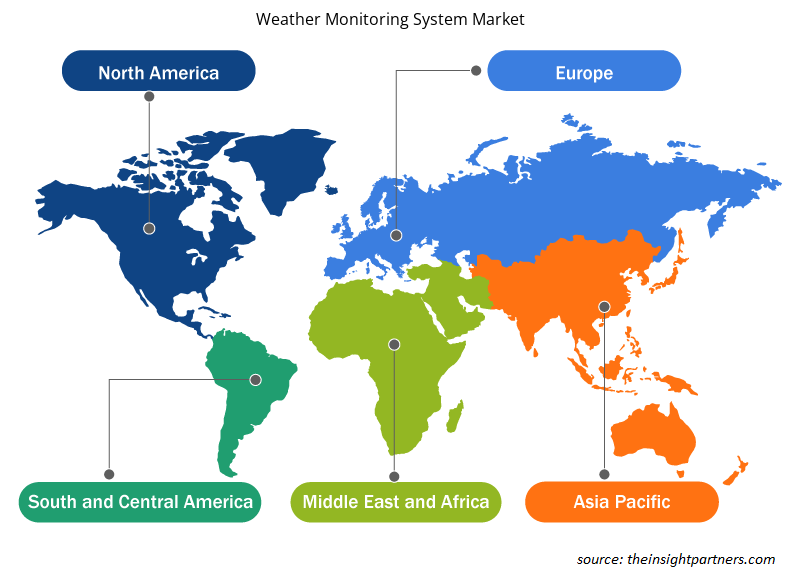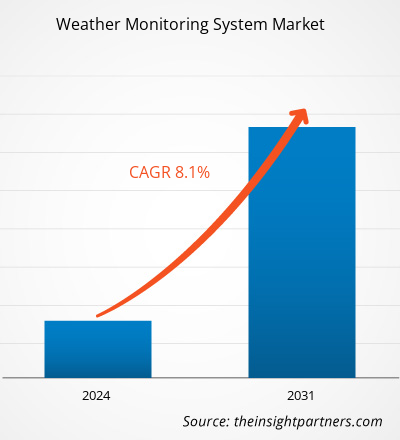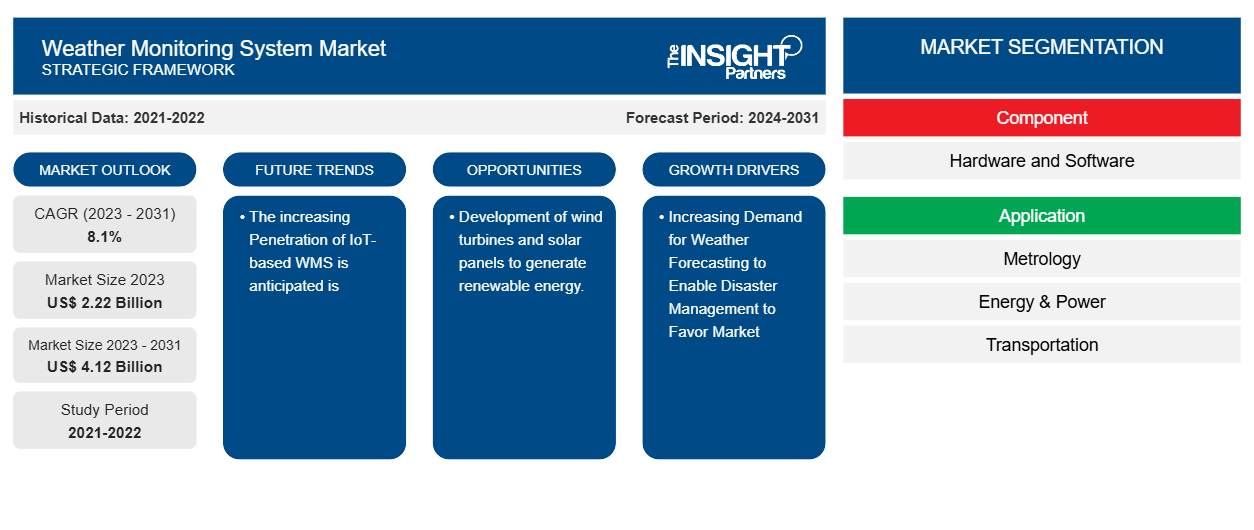Der Markt für Wetterüberwachungssysteme (WMS) soll von 2,22 Milliarden US-Dollar im Jahr 2023 auf 4,12 Milliarden US-Dollar im Jahr 2031 anwachsen. Der Markt soll zwischen 2023 und 2031 eine durchschnittliche jährliche Wachstumsrate (CAGR) von 8,1 % verzeichnen. Die zunehmende Nutzung von Wettervorhersagen zur Katastrophenbewältigung und die steigende Nachfrage nach Wettervorhersagen in der Luftfahrtindustrie dürften die wichtigsten Trends und Treiber auf dem Markt für Wetterüberwachungssysteme sein.
Wetterüberwachungssystem Marktanalyse
Der Markt für Wetterüberwachungssysteme verzeichnet weltweit ein starkes Wachstum. Dieses Wachstum ist auf den Klimawandel zurückzuführen, der zu Wetterunsicherheiten führt, und auf die zunehmende Nutzung von Wettervorhersagen zur Katastrophenbewältigung. Darüber hinaus steigt die Produktion erneuerbarer Energien, die Rechenleistung von Supercomputern für Wettervorhersagen und die zunehmende Verbreitung von IoT-basierten WMS.
Marktübersicht für Wetterüberwachungssysteme
Die kontinuierliche oder periodische Überwachung oder Analyse des Zustands von Klima und Atmosphäre, einschließlich Variablen wie Temperatur, Feuchtigkeit, Windgeschwindigkeit und Luftdruck. Darüber hinaus sind Temperatur- und Feuchtigkeitssensoren die am häufigsten verwendeten Wettersensoren. Sie können verwendet werden, um einen Hitzeindex zu berechnen, festzustellen, ob Pflanzen durch zu viel Hitze beschädigt werden könnten, oder um herauszufinden, ob es sicher ist, in einem bestimmten Bereich zu arbeiten.
Passen Sie diesen Bericht Ihren Anforderungen an
Sie erhalten kostenlos individuelle Anpassungen an jedem Bericht, einschließlich Teilen dieses Berichts oder einer Analyse auf Länderebene, eines Excel-Datenpakets sowie tolle Angebote und Rabatte für Start-ups und Universitäten.
-
Holen Sie sich die wichtigsten Markttrends aus diesem Bericht.Dieses KOSTENLOSE Beispiel umfasst eine Datenanalyse von Markttrends bis hin zu Schätzungen und Prognosen.
Markttreiber und Chancen für Wetterüberwachungssysteme
Steigende Nachfrage nach Wettervorhersagen zur Unterstützung des Katastrophenmanagements begünstigt den Markt
Die steigende Nachfrage nach Wettervorhersagen zur Unterstützung des Katastrophenmanagements ist in der Tat ein Treiber für den Markt für Wetterüberwachungssysteme. Wettermonitore/-stationen dienen als wichtige Instrumente bei der Katastrophenvorsorge und -reaktion. Indem diese Monitore genaue und zeitnahe Wetterdaten liefern, ermöglichen sie Einzelpersonen, Gemeinden und Behörden, zu planen, Risiken zu mindern und effizient auf Katastrophen zu reagieren. Wetterstationen fungieren als Brücke zwischen meteorologischen Beobachtungen und Katastrophenmanagement und fördern sicherere und widerstandsfähigere Gesellschaften. Da die Technologie sich weiter entwickelt, wird die Einführung innovativer Ansätze und die Integration neuer Funktionen die Rolle der Wetterstationen in der Zukunft des Katastrophenmanagements stärken. Unter Berücksichtigung der oben genannten Parameter ist die zunehmende Nutzung von Wettervorhersagen zur Unterstützung des Katastrophenmanagements einer der Treiber für das Wachstum des Marktes für Wetterüberwachungssysteme.
Entwicklung von Windturbinen und Solarmodulen zur Erzeugung erneuerbarer Energie.
Ein WMS ist eine der Schlüsselkomponenten eines Solarkraftwerks. Seine Funktion besteht darin, Daten zu Wetterparametern wie Moduloberflächentemperatur, Sonneneinstrahlung, Umgebungstemperatur, Windgeschwindigkeit usw. an jedem beliebigen PV-Standort zu erfassen, was bei der Überwachung der Effizienz und Leistung des Kraftwerks hilft. Die weitere Analyse dieser Daten in Bezug auf die Anlagenleistung hilft, die Leistung des Kraftwerks zu analysieren und zu verbessern. Darüber hinaus wird zur Messung der Wetterdaten des Windkraftwerks die auf dem SmartSolo-Datenlogger basierende Wetterstation auf dem permanenten Wetterturm installiert, um die Windgeschwindigkeit und -richtung in zwei Höhen sowie die Temperatur, relative Luftfeuchtigkeit und den Luftdruck zu messen. Aufgrund der oben genannten Parameter wird erwartet, dass die Entwicklung von Windturbinen und Solarmodulen zur Erzeugung erneuerbarer Energie in den kommenden Jahren mehrere Chancen für den Markt für Wetterüberwachungssysteme bietet.
Segmentierungsanalyse des Marktberichts für Wetterüberwachungssysteme
Wichtige Segmente, die zur Ableitung der Marktanalyse für Wetterüberwachungssysteme beigetragen haben, sind Komponente und Anwendung.
- Basierend auf den Komponenten ist der Markt für Wetterüberwachungssysteme in Hardware und Software unterteilt. Es wird erwartet, dass das Hardwaresegment im Prognosezeitraum einen erheblichen Marktanteil halten wird.
- Nach Anwendung ist der Markt in Messtechnik, Energie und Strom, Transport, Luftfahrt und andere unterteilt. Es wird erwartet, dass das Segment Messtechnik im Prognosezeitraum einen erheblichen Marktanteil halten wird.
Marktanteilsanalyse für Wetterüberwachungssysteme nach Geografie
Der geografische Umfang des Marktberichts zum Wetterüberwachungssystem ist hauptsächlich in fünf Regionen unterteilt: Nordamerika, Asien-Pazifik, Europa, Naher Osten und Afrika sowie Süd- und Mittelamerika.
Nordamerika dominiert den Markt für Wetterüberwachungssysteme. Der nordamerikanische Markt ist in die USA, Kanada und Mexiko unterteilt. Die Einführung von Hochtechnologie in verschiedenen Branchen in der nordamerikanischen Region hat das Wachstum des Marktes für Wetterüberwachungssysteme vorangetrieben. Faktoren wie die zunehmende Einführung digitaler Tools, hohe Technologieausgaben von Regierungsbehörden und das sich ändernde Klimamuster in der Region führen zu Unsicherheiten hinsichtlich des Wetters, und die zunehmende Nutzung von Wettervorhersagen zur Ermöglichung des Katastrophenmanagements dürfte das Wachstum des nordamerikanischen Marktes für Wetterüberwachungssysteme vorantreiben. Darüber hinaus zwingt eine starke Betonung von Forschung und Entwicklung in den entwickelten Volkswirtschaften der USA und Kanadas die nordamerikanischen Akteure dazu, technologisch fortschrittliche Lösungen auf den Markt zu bringen. Darüber hinaus gibt es in den USA eine große Anzahl von Akteuren auf dem Markt für Wetterüberwachungssysteme, die sich zunehmend auf die Entwicklung innovativer Lösungen konzentrieren. All diese Faktoren tragen zum Wachstum des Marktes für Wetterüberwachungssysteme in der Region bei.
Regionale Einblicke in den Markt für Wetterüberwachungssysteme
Die regionalen Trends und Faktoren, die den Markt für Wetterüberwachungssysteme während des gesamten Prognosezeitraums beeinflussen, wurden von den Analysten von Insight Partners ausführlich erläutert. In diesem Abschnitt werden auch die Marktsegmente und die Geografie von Wetterüberwachungssystemen in Nordamerika, Europa, im asiatisch-pazifischen Raum, im Nahen Osten und Afrika sowie in Süd- und Mittelamerika erörtert.

- Erhalten Sie regionale Daten zum Markt für Wetterüberwachungssysteme
Umfang des Marktberichts über Wetterüberwachungssysteme
| Berichtsattribut | Details |
|---|---|
| Marktgröße im Jahr 2023 | 2,22 Milliarden US-Dollar |
| Marktgröße bis 2031 | 4,12 Milliarden US-Dollar |
| Globale CAGR (2023 - 2031) | 8,1 % |
| Historische Daten | 2021-2022 |
| Prognosezeitraum | 2024–2031 |
| Abgedeckte Segmente |
Nach Komponente
|
| Abgedeckte Regionen und Länder |
Nordamerika
|
| Marktführer und wichtige Unternehmensprofile |
|
Dichte der Marktteilnehmer für Wetterüberwachungssysteme: Die Auswirkungen auf die Geschäftsdynamik verstehen
Der Markt für Wetterüberwachungssysteme wächst rasant, angetrieben durch die steigende Nachfrage der Endnutzer aufgrund von Faktoren wie sich entwickelnden Verbraucherpräferenzen, technologischen Fortschritten und einem größeren Bewusstsein für die Vorteile des Produkts. Mit steigender Nachfrage erweitern Unternehmen ihr Angebot, entwickeln Innovationen, um die Bedürfnisse der Verbraucher zu erfüllen, und nutzen neue Trends, was das Marktwachstum weiter ankurbelt.
Die Marktteilnehmerdichte bezieht sich auf die Verteilung der Firmen oder Unternehmen, die in einem bestimmten Markt oder einer bestimmten Branche tätig sind. Sie gibt an, wie viele Wettbewerber (Marktteilnehmer) in einem bestimmten Marktraum im Verhältnis zu seiner Größe oder seinem gesamten Marktwert präsent sind.
Die wichtigsten auf dem Markt für Wetterüberwachungssysteme tätigen Unternehmen sind:
- Vaisala
- Dreifaltigkeitsberührung
- Trafitek Solutions Private Ltd.
- Telegrafia als
- Boltek Blitzortungssysteme
- Freie Spirituosen Green Labs Pvt Ltd
Haftungsausschluss : Die oben aufgeführten Unternehmen sind nicht in einer bestimmten Reihenfolge aufgeführt.

- Überblick über die wichtigsten Akteure auf dem Markt für Wetterüberwachungssysteme
Marktnachrichten und aktuelle Entwicklungen zum Wetterüberwachungssystem
Der Markt für Wetterüberwachungssysteme wird durch die Erhebung qualitativer und quantitativer Daten nach Primär- und Sekundärforschung bewertet, die wichtige Unternehmensveröffentlichungen, Verbandsdaten und Datenbanken umfasst. Nachfolgend sind einige der Entwicklungen auf dem Markt für Wetterüberwachungssysteme aufgeführt:
- Eine SpaceX Falcon 9-Rakete startete am 11. April einen Wetterüberwachungssatelliten der US Space Force. (Quelle: SpaceX-Unternehmenswebsite, April 2024)
- Die indische Weltraumforschungsorganisation (ISRO) hat INSAT-3DS, einen Wetterüberwachungs- und Katastrophenwarnsatelliten, erfolgreich gestartet. Der Satellit wurde auf der GSLV-F14-Rakete von Sriharikota aus gestartet. (Quelle: ISRO, Pressemitteilung, Februar 2024)
Marktbericht zu Wetterüberwachungssystemen – Umfang und Ergebnisse
Der Bericht „Marktgröße und Prognose für Wetterüberwachungssysteme (2021–2031)“ bietet eine detaillierte Analyse des Marktes, die die folgenden Bereiche abdeckt:
- Marktgröße und Prognose für Wetterüberwachungssysteme auf globaler, regionaler und Länderebene für alle abgedeckten wichtigen Marktsegmente.
- Markttrends für Wetterüberwachungssysteme sowie Marktdynamik wie Treiber, Einschränkungen und wichtige Chancen.
- Detaillierte PEST/Porters Five Forces- und SWOT-Analyse.
- Marktanalyse für Wetterüberwachungssysteme, die wichtige Markttrends, globale und regionale Rahmenbedingungen, wichtige Akteure, Vorschriften und aktuelle Marktentwicklungen abdeckt.
- Branchenlandschaft und Wettbewerbsanalyse, einschließlich Marktkonzentration, Heatmap-Analyse, prominenten Akteuren und aktuellen Entwicklungen auf dem Markt für Wetterüberwachungssysteme.
- Detaillierte Firmenprofile.
- Historische Analyse (2 Jahre), Basisjahr, Prognose (7 Jahre) mit CAGR
- PEST- und SWOT-Analyse
- Marktgröße Wert/Volumen – Global, Regional, Land
- Branchen- und Wettbewerbslandschaft
- Excel-Datensatz
Aktuelle Berichte
Erfahrungsberichte
Grund zum Kauf
- Fundierte Entscheidungsfindung
- Marktdynamik verstehen
- Wettbewerbsanalyse
- Kundeneinblicke
- Marktprognosen
- Risikominimierung
- Strategische Planung
- Investitionsbegründung
- Identifizierung neuer Märkte
- Verbesserung von Marketingstrategien
- Steigerung der Betriebseffizienz
- Anpassung an regulatorische Trends























 Kostenlose Probe anfordern für - Markt für Wetterüberwachungssysteme
Kostenlose Probe anfordern für - Markt für Wetterüberwachungssysteme